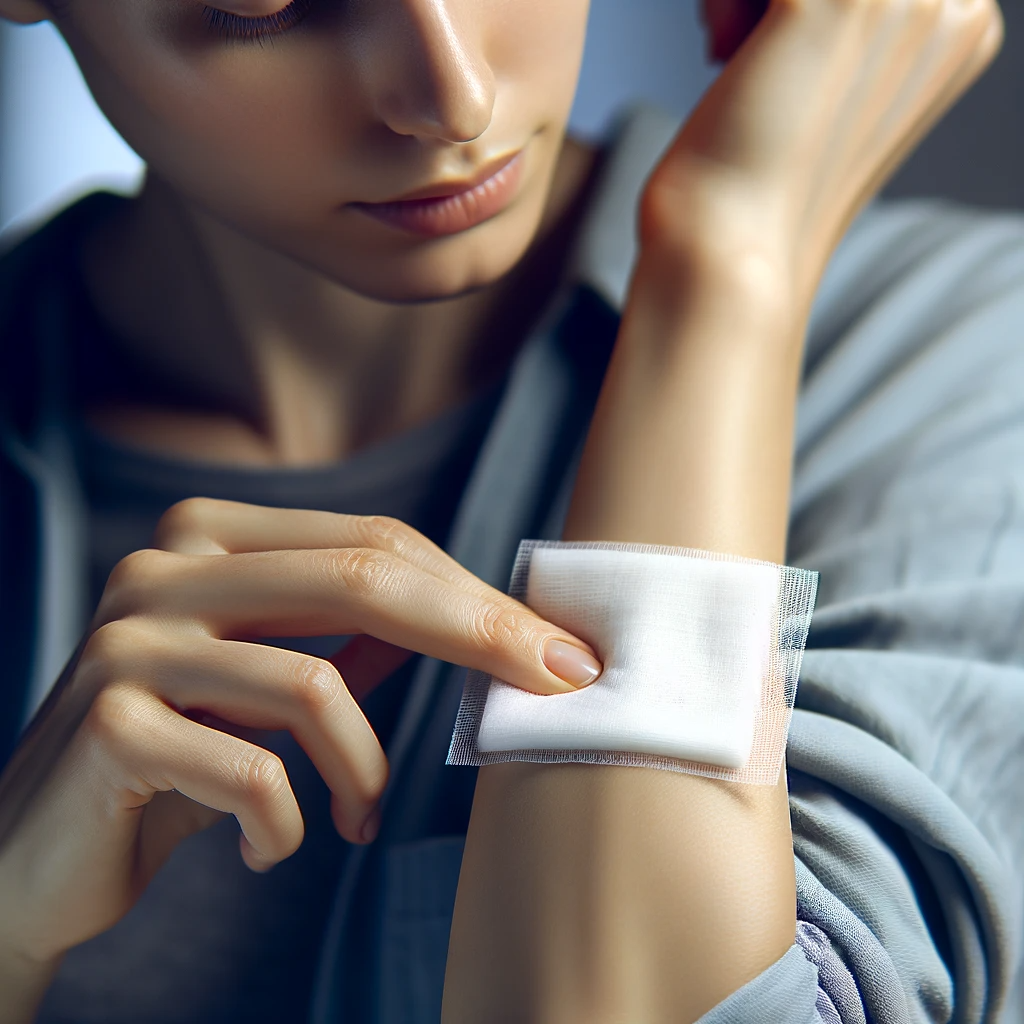ELI5 Summary:
Skin tags bleed a lot because they have a core of blood vessels and are often located in areas where they’re subject to friction or injury. This combination of a delicate structure and external irritation can easily lead to bleeding. Simple home care can manage a bleeding skin tag, but if bleeding is persistent or problematic, professional medical advice should be sought.
Bleeding Skin Tags: Demystifying the Red Rush
Have you ever noticed a tiny flap of skin that seems innocuous until one day, it decides to make its presence known with a surprising spot of blood? Skin tags, medically known as acrochorda, are indeed those benign little growths that often warrant no more than a quick glance. But when they bleed, they suddenly demand our undivided attention. In this deep dive, we’re going to unravel the mystery behind why do skin tags bleed so much and how such small entities can cause such a startlingly red flow.
Bleeding can turn a harmless skin tag into a source of concern. It’s not just about the blood, but also about the implications of it. Is this normal? Should I be worried? These are the questions we’ll tackle head-on, leaving you informed and ready to handle your skin’s quirky behaviors with aplomb.
What Are Skin Tags and Why Should You Care?
Skin tags are small, soft, flesh-colored growths that typically occur on the eyelids, neck, armpits, groin folds, and under the breasts. They are composed of loose collagen fibers and blood vessels surrounded by skin. Although skin tags are generally harmless and painless, they are curious in their capacity to bleed. Here’s why they matter:
- Prevalence: Almost half the population will develop at least one skin tag in their lifetime, making understanding them relevant to many.
- Esthetics: While painless, they can be a cosmetic nuisance, especially if located in visible areas.
- Friction: They frequently surface in areas where skin rubs against skin, leading to irritation or damage which may cause bleeding.
- Indicator of Health: In rare cases, numerous skin tags can be a sign of an underlying health condition like diabetes or hormonal imbalances.
Given these factors, knowing the ins and outs of skin tags can help you make informed decisions about your health and skin care.
Prevalence and Perception: A Look at the Stats
Did you know that skin tags are the most common benign skin growth in adults? With a significant portion of the adult population sporting at least one, it’s surprising how little public awareness there is. Here’s what the statistics say:
- Up to 59% of adults will experience skin tags at some point in their lives.
- Skin tags are more common in middle age, especially in women, particularly during pregnancy due to hormonal fluctuations.
- People with diabetes or those who are overweight are at an increased risk due to higher instances of skin friction and insulin resistance.
Despite their prevalence, there’s a stigma attached to skin tags that can affect self-esteem. By shedding light on these stats, we normalize skin tags and arm ourselves with knowledge against misconceptions.
Uncovering the Reasons Behind Skin Tag Bleeding
Understandably, when something on your body begins to bleed, it’s a red flag that demands investigation. Skin tags are prone to bleeding due to several factors, some intrinsic to their structure and others influenced by external forces.
While a bleeding skin tag is usually not a cause for alarm, understanding the whys and wherefores can provide peace of mind and guide appropriate actions. Let’s delve into the anatomy of these peculiar skin inhabitants and unearth the reasons that set the stage for their occasional dramatic displays.
The Anatomy of a Skin Tag: Why They’re Prone to Bleeding
At a glance, a skin tag may appear insubstantial, but there’s more to these protrusions than meets the eye. Their anatomy makes them surprisingly vulnerable to bleeding:
- Collagen Fibers: Skin tags are composed of loose collagen fibers—proteins that make up much of our skin and connective tissues.
- Blood Vessel Networks: A network of blood vessels operates beneath the tag’s surface; injury to these can result in excessive bleeding.
- Skin Wrapper: The overlying skin, though it protects, is often thin and delicate, making it susceptible to tears.
This tissue composition coupled with a thin covering means that even minor abrasions can sever the blood vessels and lead to bleeding.
External Factors That Trigger Bleeding
Beyond their physical structure, external elements play a role in why skin tags may bleed. Day-to-day activities can inadvertently put skin tags at risk. Here’s what could set the stage for a bleed:
- Friction: Skin tags often occupy real estate where they’re prone to rubbing against clothing or other skin, leading to abrasion.
- Accidental Snags: Jewelry or razors can catch on skin tags during dressing or grooming, pulling or severing them.
- Inflammation: Skin conditions like eczema can inflame the skin, skin tags included, making them more friable.
Recognizing these triggers serves as a first step toward preventing unnecessary bleeds and maintaining the integrity of your skin’s surface.
First Aid for Bleeding Skin Tags
When faced with a bleeding skin tag, the right response can make all the difference. Quick and appropriate first aid reduces the risk of infection and promotes healing. Whether you’re at home, work, or out and about, having the know-how to handle a bleeding skin tag can spare you unnecessary discomfort and potential complications.
Let’s walk through the immediate steps you should take if you find yourself dealing with a bleeding skin tag, and investigate when it’s time to transition from at-home care to professional medical advice.
Immediate Steps to Control the Bleed
No matter the cause of bleeding, the objectives are clear: stop the bleeding, clean the wound, and protect the area from further injury. To achieve this, follow these straightforward steps:
- Apply Gentle Pressure: Use a clean, soft cloth or a sterile gauze pad to apply light pressure to the area for a few minutes.
- Clean the Wound: Once the bleeding has stopped, carefully clean the area with mild soap and warm water to prevent infection.
- Antiseptic Application: Apply a thin layer of an over-the-counter antiseptic to further ward off bacteria and encourage healing.
- Bandage if Necessary: If the skin tag is in a location where it may continue to rub against clothing or get irritated, cover it with a small bandage.
Remember, gentleness is key. Being too harsh with a delicate skin tag can exacerbate the problem.
When to Seek Medical Attention
Most of the time, bleeding skin tags are manageable at home. However, there are certain scenarios where seeking medical attention becomes essential:
- Persistent Bleeding: If the bleeding doesn’t stop with direct pressure, this could indicate a deeper issue.
- Signs of Infection: Redness, swelling, warmth, or pus around the skin tag are red flags signaling infection.
- Change in Appearance: If a skin tag changes color, shape, or size, a doctor should examine it to rule out other skin conditions, like melanoma.
- Severe Pain: Pain inconsistent with a minor cut or scratch can be a reason to consult a healthcare professional.
When in doubt, it’s always better to err on the side of caution and get a professional opinion. This ensures not just your peace of mind, but also the health and safety of your skin.
Preventive Measures and Daily Care
While you can’t always prevent skin tags from forming or bleeding, there are steps you can take to reduce their risk and manage their presence effectively. With a focus on proactive care and daily management, you can keep your skin healthy and reduce the chances of turning your skin tags into a bleeding concern.
Let’s explore the daily measures that can keep those tag-related troubles at bay and underscore the no-triggers-left-behind approach to skin tag care.
Protecting Your Skin Tags from Injury
The key to protecting skin tags is minimization of friction and irritation. Here are some preventative strategies:
- Wear soft, loose-fitting clothes: Avoid tight garments that can rub against skin tags, especially around the neck, groin, and underarms.
- Avoid jewelry that can snag: Be mindful of necklaces, bracelets, and watches that might catch on skin tags.
- Be gentle with grooming: Take special care when shaving or drying off with a towel to avoid tugging at skin tags.
- Maintain skin hygiene: Cleanse areas prone to skin tags gently but thoroughly to maintain skin health.
- Consider barriers: In areas of constant friction, small adhesives or dressings can protect skin tags from irritation.
Implementing these daily habits can go a long way in ensuring your skin tags remain unbothered and intact.

Lifestyle Changes to Reduce Skin Tag Formation
While skin tags are often a genetic lottery draw, lifestyle changes can influence their frequency and severity. Consider the following adjustments:
- Maintain a healthy weight: Excess weight can increase the folds of skin and areas of friction where skin tags thrive.
- Balanced diet: A diet rich in fruits, vegetables, and whole grains can improve overall skin health and potentially reduce skin tag formation.
- Regular exercise: Exercise can help manage weight and improve circulation, promoting healthier skin.
- Manage blood sugar levels: Keep diabetes under control to potentially limit skin tag development related to insulin resistance.
These lifestyle tweaks not only promote better skin condition but also bolster overall health, creating a robust environment where skin tags are less likely to find their footing. The aim here is two-fold: care for the tags you have and create a climate that’s less conducive to new arrivals.
Professional Removal Techniques
When home remedies and preventive steps are not enough to deal with skin tags, or if they frequently bleed and cause discomfort, professional removal may be the next logical step. Modern removal techniques are numerous, each with its own set of benefits and considerations. Understanding your options will empower you to make an informed decision in consultation with your healthcare provider.
Let’s examine the professional avenues you have at your disposal for dealing with persistent or problematic skin tags effectively and safely.
Understanding Your Options: From Cryotherapy to Surgery
Here are the most common professional methods for skin tag removal:
- Cryotherapy: Liquid nitrogen is applied to freeze the skin tag, causing it to fall off within a few days.
- Excision: A doctor may use a scalpel or surgical scissors to cut the skin tag away.
- Electrocautery: Burning off the skin tag with electric current is another effective method.
- Laser removal: A concentrated beam of light destroys the skin tag, typically with minimal scarring.
- Ligation: The blood supply to the skin tag is cut off by tying it off with surgical thread, causing it to drop off.
Each method comes with its level of discomfort, cost, and healing time, but they are generally minimal and manageable procedures. A healthcare professional can help you weigh these factors and choose the most suitable option for your situation.
Preparing for Treatment: What You Should Know
Prior to undergoing any procedure, there are important considerations to keep in mind:
- Consultation: Schedule a consultation with a dermatologist to get a clear diagnosis and discuss the best removal method for you.
- Insurance: Check with your insurance provider as skin tag removal is often considered cosmetic and may not be covered.
- Post-treatment care: Understand the aftercare process to ensure a swift and clean healing period.
Preparing for skin tag removal involves ensuring you have the right information and expectations. With a confident approach and professional guidance, you can address your skin tags with minimal stress and optimal results.
The Psychological Impact of Skin Tags
Skin tags, while medically harmless, can have a profound effect on an individual’s psychological well-being and self-image. The aesthetics of visible skin tags can lead to self-consciousness and social anxiety, particularly in cultures that prize unblemished, smooth skin. Recognizing and addressing the emotional layer of living with skin tags is as important as tackling the physical aspect.
In this section, we’ll touch on the emotional narratives that accompany skin tags and provide reassurance that such feelings are valid and common. We’ll also explore ways to bolster confidence and mental health while dealing with skin growths that can sometimes feel like more than just tiny flaps of skin.
Facing Social Stigma: Real Stories of Emotional Challenges
Many individuals with skin tags share experiences of embarrassment or shyness about their skin’s appearance. These stories often involve:
- Self-Consciousness: Worry about others noticing their skin tags, especially in high-visibility areas like the face or neck.
- Social Anxiety: Avoiding social situations or physical intimacy to prevent the tags from being seen or felt.
- Bullying or Teasing: Dealing with insensitive comments can compound feelings of embarrassment.
The collective voice of these experiences underscores the need for a supportive and understanding approach to the psychological side-effects of skin tags.

Boosting Self-Confidence: Moving Beyond Skin Deep
While the physical presence of skin tags can be addressed by the methods previously discussed, managing their emotional impact involves a different kind of care:
- Support Networks: Reaching out to friends, family, or online communities can normalize the experience and provide a sense of belonging.
- Professional Help: If skin tags profoundly affect daily life or self-esteem, speaking with a counselor or therapist can be beneficial.
- Education: Understanding that skin tags are common and benign can demystify them and reduce stigma.
- Empowerment through Action: Taking control by seeking medical advice or removal can also improve mental well-being.
Empathy, education, and action are the pillars of transforming the psychological impact of skin tags from a negative imprint to a beatable challenge. Embracing and caring for your unique skin, tags and all, is a powerful step towards self-acceptance and confidence.
Conclusion: Embracing Skin Health with Knowledge and Confidence
As we conclude our journey exploring the enigmatic world of skin tags, it’s essential to reflect on the key takeaways. Skin tags, those peculiar little growths, are mostly a cosmetic concern, yet understanding why they bleed and how to manage them can alleviate fears and promote better skin health.
Throughout this exploration, we highlighted the importance of recognizing the anatomy of skin tags, the causes behind their bleeding, and how to respond effectively with first aid. Practical advice on preventive care and when to consider professional removal were discussed to empower you with choices for your skin’s care.
Moreover, we delved into the psychological aspect, acknowledging the mental and emotional influences these small growths can have on one’s life. By fostering support, seeking help when needed, and ultimately, understanding and accepting one’s body, individuals can find confidence and peace of mind.
Whether you decide to leave your skin tags as they are, take steps to prevent their formation, or opt for removal, the most important point is that you are now equipped with information and strategies to make informed decisions for your skin’s health and your overall well-being.
Remember that skin tags are common, often harmless, and manageable with the right approach. Embrace the skin you’re in with knowledge, care, and a dose of confidence, knowing you have the power to take control of your skin’s health.
Citations:
- https://uvderm.com/skin-conditions/skin-tags/
- https://www.currentderm.com/skin-tag-removal/#:~:text=Walterhoefer%20and%20Flahive%20can%20remove,the%20lesion%20for%20full%20removal.
- https://www.medicalnewstoday.com/articles/cancerous-skin-tags#:~:text=A%20person%20can%20talk%20with,be%20harmful%2C%20including%20skin%20cancer.
- https://www.verywellhealth.com/how-to-prevent-skin-tags-5112626#:~:text=There’s%20no%20definitive%20way%20to,are%20most%20likely%20to%20develop.




